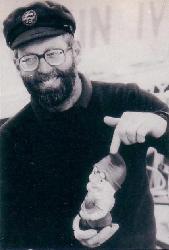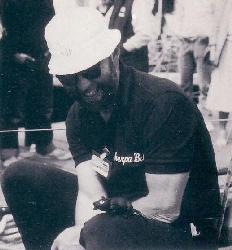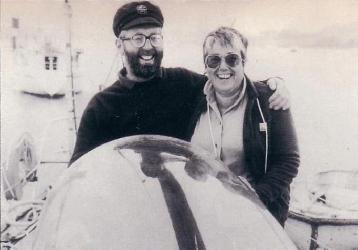Yachting Monthly December 1986
Biggles and the black rat
For the last few days of the 1984 OSTAR, every squall, gale and storm in the North Atlantic seemed to be doing its best to stop BILL PERKES from reaching Newport, until a smiling companion had a quiet word in his ear …
TWO HUNDRED miles south of Nova Scotia, the sky and sea were black beyond belief, except for the stark contrast of livid light from lightning bolts striking the sea all around. I could barely hear the thunder as the scream of the wind tore at the rigging and the waves broke with an unimaginable noise. The noise was ceaseless, flooding my mind and putting my senses into a dreamlike trance.
It had been a frustrating few days. I was taking part in the 1984 OSTAR in Sherpa Bill, my faithful old 36ft Excalibur which is a truly magical boat; we have travelled many miles together.
So far the race had been fairly routine, with the normal number of gales, headwinds and general unpleasantness, but now the hoodoo struck with a vengeance. An unprecedented low, small but vicious, had developed in a sea area where normally the winds should have eased off and allowed Sherpa Bill to do her easy 5 knots in little or no wind. The wind had built up all day and I had gone through all the normal traumas of reducing sail from full main and light genoa to headsail change, to reef until, by late -afternoon, I was down to full reefed main and workingjib, crashing close-hauled into a very nasty breaking sea.
At this stage. in the game, the radar detector (Lo-Kata) started bleating out its warning. I ignored it at first, as sometimes the Argos tracking unit on the afterdeck sets it off. But when it became a more regular bleep, I took a rough bearing and found the source was almost dead to windward. I had a look and saw nothing, switched on the VHF on Channel 16 and called up. ‘Vessel on my port bow, this is yacht Sherpa Bill. Do you see me?’
A clear Canadian voice answered. ‘This is the fishing boat on your port bow. We thought we saw a blip on our radar a while ago, but you are now lost in the clutter of the waves.’ He sounded very calm. It’s all right for some. I explained that I was on my own and what I was doing, and asked him not to hit me. He told me that the low had been completely unforecast but should clear in about 24 hours. Conditions, he said, would get worse before they got better.
Thanks a lot! Some time later, he called again to say that he could now see me and was unhappy that I was not showing any lights. As it was not yet dark I had not bothered. However, the low scudding clouds made the scene very gloomy and I reached for the switch.
I peered out and there he was, running down on me with two long poles in a great vee to the sky, rolling so that in turn they came parallel to the sea. We talked on the radio for a while, a relief from the emptiness, as this was only the second ship I had seen in 10 days. He called once more, from two miles off, and said he could see me on the radar again, wished me luck and was gone.
By midnight Sherpa Bill was in the middle of the low. The wind was down to nothing and the sea had gone mad.
In anticipation of even more wind to come, I was down to storm Jib only and Sherpa Bill was rolling and pitching wildly with no forward movement at all. The seas crashed aboard from ahead and at the same time gave almighty thumps up the counter. Somehow I worked the boat round on to the other tack, and when the wind slowly came back she did settle down to what one could call a semblance of sailing.
By dawn the scene was very wild indeed, but the waves had increased enough in height and length to give us a chance. Before midday, a blue patch appeared to windward and spread rapidly across the sky; I was amazed to sail from under low black storm clouds into clear blue sky. The wind swung from south-west Force 7-8 to northerly Force 2-3 in about five minutes. After giving it a while, in case there were any squalls under this incredible change of conditions, I put up the main, took out the reefs and raised the heavy genoa. There followed a weird bit of sailing as the seas were still running high from abeam but rolling up from leeward with Sherpa Bill sailing close-hauled. The waves pushed the boat up into the breeze causing her to heel and then the wave would break aboard on to the depressed lee side. As the wave passed, the wind pressure came off and the boat would roll again to windward throwing off any speed she had gathered – and so on for several hours until the sea evened out.
The 24-hour run towards Newport, Rhode Island, was pathetic but it got even worse. Towards evening the sea and wind eased right down and by midnight we were completely becalmed. This state of affairs lasted until early afternoon the following day. Another disastrous day’s run. The contrast from the last few days was extreme. It now seemed like eternal blue skies and sunshine which, in spite of being more comfortable than the constantly changing movement of the gale, was not getting us to Newport very fast.
The sea crashed aboard from ahead and at the same time gave almighty thumps up the counter
As the afternoon wore on, I saw a small cloud to the north-west and thought that perhaps there might be some wind associated with it, so headed that way. But the wind was so light and our speed through the water so slow, that it made very little difference which way we pointed.
The clouds grew apace and slowly spread out in formation. The wind picked up and with about an hour and a half to go before dark I realised that we were in for trouble yet again. The clouds built up to the north-West and spread across the sky leaving a clear lurid gap beneath them, through which the unfriendly looking sun sank slowly into the sea. Above the clouds which had not yet reached me, the lightning jumped from end to end, from horizon to horizon, in great leap-frogging flashes; and, more worrying still, short vicious streaks struck from beneath these clouds into the sea.
At this stage, I felt that it was best to get clear of this area as quickly as possible, so as the wind slowly but relentlessly hardened from abeam, I left everything up in an attempt to reach across the front of the disturbance and out of the way. After an hour with our speed reaching dizzy heights in the comparatively flat water, I realised that this storm was going to be bigger than any I had experienced before. I went through the whole phase of reducing sail until, by 2200, Sherpa Bill was down to bare poles and the storm was upon us.
If there is one thing which is really frightening at sea it is to have lightning striking into the water all around you, knowing that your mast is the highest thing for a couple of hundred miles. I disconnected all the aerials, radio, satnav and VHF. I even unbolted the sets and stowed them away.
I was frightened.
I got out my ‘panic gear’, which was already prepared in plastic bins, together with two boxes of flares and a full bottle of fresh water. These slid round the galley floor until I could wedge them in, while poor old Sherpa Bill rolled and pitched like a mad thing.
I put on my survival suit and although it was soon as wet inside as out, at least it provided some warmth. Three hours later there was no sign of abatement. If anything, it seemed to be getting worse. I made up a drink of orange juice in a bottle with a liberal addition of rum, the traditional backbone stiffener. This, together with a large bar of chocolate, calmed me, if not the weather. We had not been struck by lightning yet, although every stark flash and crack seemed to make me cower just a little bit more. The scene in the lightning flashes was like a black and white photo graph, with the waves and spray frozen for an instant in the light.
. . . under the canopy stands Biggles, smiling and completely oblivious to the conditions outside
I could do no more, so I climbed into a bunk. This was easier than the strain of hanging on. I must have gone into a trance of fear, a drunken stupor or maybe, as I like to think, I just went to sleep. It was several hours later when I came to and found the storm still raging and the lightning flashing; but now it did not seem to be so directly overhead.
Towards dawn, things began to steady down, but the wind was still blowing 40 knots. With just the stormjib up we were making about 2 knots at almost 90 degrees to the course for Newport.
That morning, the sun started to break through again and I spent three hours in the companionway just watching, amazed at the seas and the way the old boat was dealing with them in a most masterly fashion. All the while the Aries self-steering gear had handled the steering without a mistimed move. It would have needed another three crew members to have come so well out of the last days.
I could now stand without more than the normal discomfort in the companionway because the washboards were in place. Overhead I had an aircraft cockpit canopy, which not only gave a good all-round optical view but also helped streamline the companionway.
Forward of the instruments at the front of the companionway, under the canopy, stands Biggles, smiling, completely immune to the conditions outside. He is called Biggles not only because he is in the pilot’s seat, but also because he has a pair of goggles pushed up on to his hat.
Biggles is a gnome. When he first arrived on board he could not quite stand up straight, but after one very hot, sunny day en route to the Azores the previous year, his hat melted sufficiently for him to be able to stand comfortably. And, as any Biggles enthusiast will tell you, it is a well-known fact that Biggles is bent. I always like to think I am liberal in my views and have never let this fact spoil our’ relationship.
So when, on this particular morning, I heard him sigh I turned him round to face me so that we should be able to converse more comfortably. I thought his smile was somewhat frozen.
‘It’s that bloody Rat,’ he said.
‘Oh yes,’ I replied, ‘how do you make that out?’
‘It’s the Rat,’ he repeated, ‘that’s the cause of all the trouble.’
Here was food for thought from a completely new angle; always a good thing after several weeks alone at sea. The thought processes slow down. I pondered for a while. He could have a point.
The Rat – The Black Rat – was a rather nasty looking plastic animal that shared the look-out position with Biggles. Because of the motion, it had spent most of the time lying on its back with its feet in the air pretending to be dead. The Rat – for no other name had been given to it – had been given to me as a joke, not in the best of taste I agree, by my old friend Graham Adams before the start of the race.
Now Graham was not participating in this race, and the theory that Biggles had was that, by giving us the Rat and thus casting a hoodoo on us, it would slow us down sufficiently so that, if ever he did the race, he could do so in a faster time. And I would never hear the end of that!
The solution was to cast the Rat overboard in the general direction of England and at the same time utter a series of chants to undo the spell. This was duly prepared and enacted dead on midday in keeping with sun rites. The gale was blowing just as strongly as before.
Do you know that within 20 minutes the wind had shifted 30 degrees and moderated from a Force 8 to between 6 and 7, enabling us to tack and point the right way for the first time in days!
Up went the trysail and the speed from 2 to 51/2 knots. Not only that, but we were now close-hauled and sailing along the old seas and not smashing into them. Slowly the wind and the seas quietened and Sherpa Bill sailed as well and as fast as I have ever known; for the next week we were never headed.
I turned Biggles back to his normal forward facing position. ‘I will keep a watch and an eye on the sails,’ he said. He did not smile; he positively grinned, and I swear that, as he turned, he gave me a large meaningful wink. <>
Bill Perkes, 50, has sailed over 45,000 miles in Sherpa Bill, his 36ft Van de Stadt-designed
Excalibur. He has taken part in three Round Britain Races and the 1981 and 1986 TW0STAR and1983 Azores and Back Races. A Yachtmaster
Instructor and charter skipper (on Sherpa Bill), Bill and his wife Hazel are due to take part in JimmyCornell’s ARC Race from the Canaries to Barbados, beginning at the end of November.
A hot sun en route to the Azores the previous year meant that Biggles could stand up comfortably for the first time.
The Rat, who shared Biggles’ lookout.
Bill and Hazel Perkes on Sherpa Bill shortly before leaving for the Canaries in October.
Sherpa Bill being towed out for the start of the 1984 OSTAR. (no picture available).



